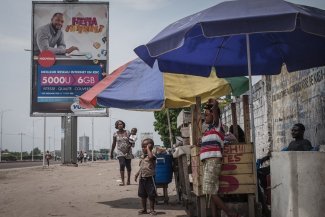Carmela (left), from Spain, and Piri (right), from Romania, share a plot on the social allotment in Molina de Aragón, Guadalajara.
It looks like any other allotment, but it contains the seeds of something more than vegetables and potatoes. A group of teenagers plant tomatoes with a man from Bulgaria, a Spanish woman shares a watering can with another from Romania, and cauliflowers grow alongside Rau Muong, an exotic variety of spinach from Vietnam.
“The allotment is like a little multicultural city,” says Carmela, a resident of Molina de Aragón. This town in the Spanish province of Guadalajara is representative of what is known as “empty Spain”, the vast swathes of the country – almost half of the territory – that have been losing inhabitants in the rural exodus of recent decades. This sparsely populated Spain of isolated and ageing communities can only be compared with the bleak snowscapes of Lapland.
In this area, for example, there are 80 villages, but they do not even have 9000 inhabitants between them. There are two people per square kilometre. “You have to like it to be able to live here. It’s a very quiet place, not at all like the city,” says Piri, whilst harvesting a few vegetables. She came from Romania 10 years ago and has been living in Molina de Aragón with her two children ever since. Hers is one of the dozens of migrant families that have been repopulating parts of deserted Spain since the 1990s.
“The rural landscape has changed. It’s more diverse and multicultural now. It’s no longer unusual to see Latin Americans working in the village bar or women wearing headscarves picking up their children from school,” explains Rosario Sampedro, a sociology professor at the University of Valladolid and chief researcher of a project on crisis and immigration in the rural environment.
“There are rural areas that have managed to keep up their population levels and even grow, that have managed to keep their schools open, thanks to the arrival of migrants. These people are reviving villages, and not only in demographic terms. They are supporting their economic and cultural life too,” she underlines.
According to a study by the think tank Real Instituto Elcano, the arrival of foreign residents between the year 2000 and 2008 played a “crucial role in halting the demographic decline”. Whilst in the year 2000, immigrants accounted for 1.8 per cent of the population in rural Spain, the percentage had risen to 9.3 per cent eight years later. The mother and/or father of one in 10 of the children born in Spanish villages in 2008 were immigrants.
The new residents
The municipality of Aguaviva, in Teruel, was one of the first to realise the need to attract new residents, to breathe new life into communities being sapped by depopulation. In the year 2000, the local authority launched a pioneering plan to repopulate the village with migrants. It offered work and housing to families from Latin America, Argentinians in the main. To its surprise, however, the project was not a success.
Many of the new residents packed up and left very soon after their arrival. No one had warned them about the difficulties of living in a place with very few services and such poor communications, and nothing was done to integrate them. They were invited without consulting the locals first, which created a climate of mistrust.
“Integration has to be worked at, and the action taken by local authorities is crucial. They have to smooth the way, to avoid any conflict or misunderstandings. Seeing immigrants as no more than labour invariably creates problems,” points out Sampedro.
Molina de Aragón also has a programme for attracting new residents, but its strategy is different. “The first thing we do is to assess the needs of the village and identify the jobs that are not being covered by the local population,” says Marta Tercero, the local coordinator of the NGO Cepaim. These jobs are then offered through the Nuevos Senderos (New Pathways) project to migrant families who are living in the city and want to move to rural Spain.
“But not anything goes. We look for jobs offering decent conditions, in places with adequate housing, and families that really want to get involved.”
Around 20 per cent of the people now living in Molina de Aragón are of foreign extraction. Community action and integration activities are crucial to the success of the programme. An everyday place such as an allotment becomes a space where old and new residents come together, interact and get to know each other by name, regardless of their nationality.
More than Vietnamese spinach
“Shepherd required in the municipality of Pareja. Preferably a family with children.”
This is one of the latest job offers posted by Cepaim, but the NGO acknowledges that offers like this are increasingly rare. Nowadays, with a 23 per cent rate of registered unemployment among foreigners, as compared with 17 per cent among nationals, they too are starting to leave.
Rather than trying to attract new residents, the goal is now to try and prevent those already there from leaving.
“I’ve been looking for work for years, but no luck. I’m still holding out, but I have already decided that if nothing comes up, I’m going to leave,” laments Olga, an Ecuadorian woman living in Molina de Aragón.
The fact is that the agriculture and livestock sector only provides seasonal work, and very little of it. With construction still at a halt, due to the 2008 financial and economic crisis, and the cuts in public sector employment, the only alternative is the service sector, which has also been affected by a fall in customers.
The International Organization for Migration (IOM) is working to promote self-employment. “We offer training to immigrants living in rural areas, to help them to draw up a business plan. We are providing advice and assistance, for example, for projects to set up an online handicraft shop or to open a confectionery,” explains Silvia Bellomo, integration project coordinator for IOM in Spain.
But much more remains to be done. “Jobs are needed, but what is needed above all is stable employment. This is essential for people without a family network,” says Ana María Corral, head of the migration department of the UGT trade union centre.
She also recalls that the local authorities and labour inspectorate should be doing more to tackle the underground economy and the abuses that often remain hidden in rural areas, be it on farms or in homes employing domestic workers.
Everyone agrees on one point: planting spinach from Vietnam is not enough to bring new life to the empty villages of Spain. “It is a political problem, and it can only be solved by political means,” says Miguel del Yukon, a member of La Otra Guadalajara (The Other Guadalajara), a citizens’ initiative fighting rural depopulation.
They are calling for measures to stimulate employment, such as special taxation so that entrepreneurs in rural areas are not faced with the same costs as in the city.
They are also proposing that the government dust off the Rural Development Law, which was passed in 2007 but has not yet been allocated a budget. The idea is to overcome the rural disadvantage – poorer communications, scarcer housing and services – and to help make these areas more attractive places to live, for migrants and for everyone.
Now, as even the United Nations is looking to integrate refugee families in depopulated rural environments, trade unions and NGOs are highlighting the fact that the government cannot expect these people to settle where Spanish citizens refuse to live, just to fill Spain’s empty spaces.










